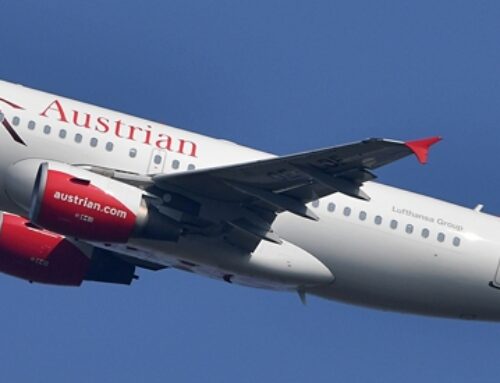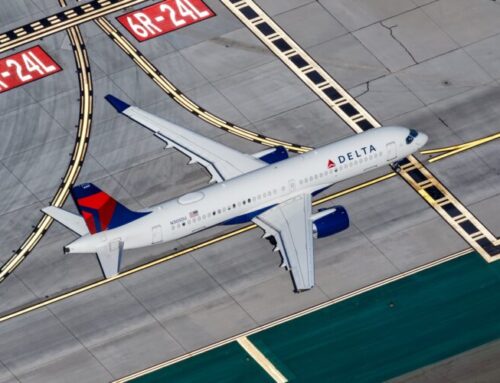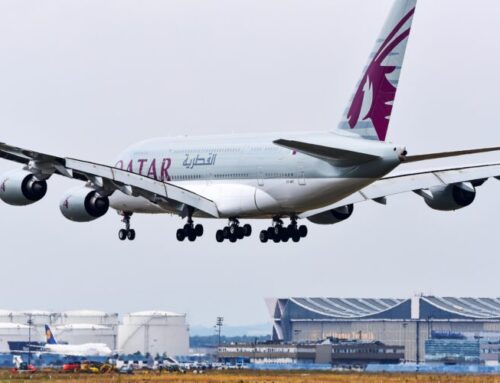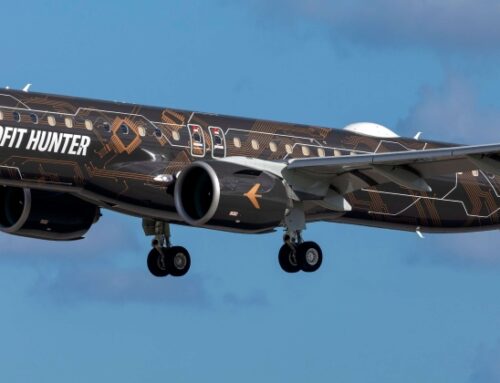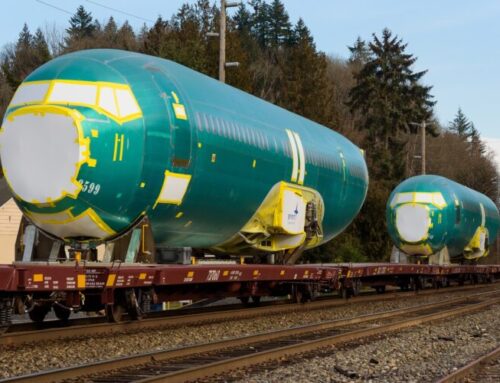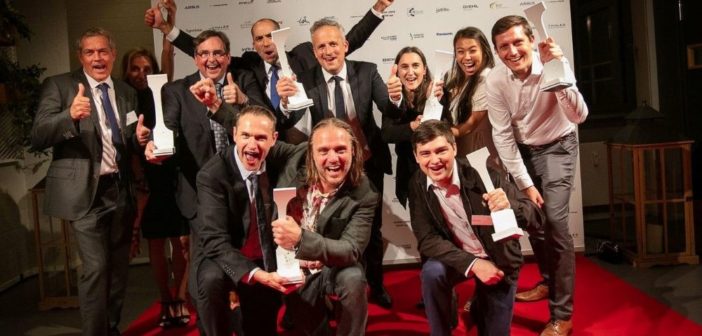
2022 is a special year for the Crystal Cabin Awards (CCAs), the world’s foremost prize honouring excellence and ingenuity in aircraft interiors. During the most turbulent time aviation has ever experienced, with Covid-19 travel restrictions sending shockwaves through the industry, the awards adapted, with new types of product included (many hygiene or cargo related) and the winner presentations held online. Now that air travel is back – and recovering strongly and at speed – the CCA judging panel not only met in person once at this year’s judging event, but the awards ceremony was an amazing live event. The ceremony was a big moment for all involved in the awards, and for the wider industry.
A little background
So how does the judging process work? As a little background, everyone is welcome to submit an entry for the CCAs, and indeed many do. Once the entry deadline has passed, an initial assessment phase by a pre-selection committee follows in which every entry is considered, and those that are not eligible to progress further are removed. Reasons for removal can include a lack of innovation, or being a previous shortlisted entrant without sufficient further changes, among other reasons. A team checks that those entries that remain are in the correct category (there are eight categories) and the shortlist is prepared for the first round of judging.
The shortlist for 2022, the 16th year of the awards, was a little shorter than in previous years. While we usually assess more than 100 shortlisted entries, this year we ‘only’ had 63 entries to consider – still a substantial number, and one that is bound to expand next year in line with growing industry recovery and confidence.
These 63 entries were then assessed by the judging panel and an initial round of voting followed (judges with any conflict of interest have to abstain from participating in the relevant category/s). With the 28-strong panel located around the globe, in-person meetings are problematic to arrange, so this first round of voting is conducted online, but there are plenty of opportunities to discuss any queries. The process involves a fair amount of work and time, but the panel always finds it interesting to see such a breadth of cabin innovation. The votes are then cast according to criteria of the degree of innovation, the benefit and utility to operators and passengers, and the 24 highest-ranked entries make it through to the finalists stage: three in each of the eight awards categories.
The next stage is the in-person voting. At lest one-third of the 28-strong judging panel is required to be present at the voting session, but in reality the vast majority attends every year. On the day before the start of Aircraft Interiors Expo, the panel convenes at a top-secret location (just to the rear of Hamburg Messe), where representatives from the finalists present their entries in greater detail to the jury and answer their questions. Finalists are encouraged to bring physical prototypes or demonstrators, to aid the judges in their evaluation, and if any entries are on show at the Expo, we will bravely negotiate our way through the construction teams setting up the showfloor to try them (look out for our dayglo tabards). Then the final votes are cast, we swear an oath of secrecy not to disclose the results before the ceremony the following evening and – most importantly – head for dinner.
So who won the 2022 awards?
Category: Cabin Concepts
Purpose: This category rewards design innovation and differentiation in aircraft cabins, both of today and tomorrow. Cabin concepts can be submitted by airlines, aircraft and cabin manufacturers, design companies and MROs alike.
Winner: Elevate, by Teague and Nordam
Elevate was one of the entries that attracted the most media attention when the shortlist was announced, a design that is visually arresting and that focuses on single-aisle aircraft: the fastest-growing area of aviation, especially with more narrowbodies being used on transcontinental routes. Premium customers on these routes are accustomed to widebody suites, such as Virgin Atlantic’s Upper Class or British Airways’ Club Suites, and they will expect the same level of experience in a narrowbody. JetBlue is moving into the gap with its A321LR Mint suites but more options will be needed to meet demand.
The Elevate design uses ‘floating’ furniture to create a premium cabin that will please passengers by giving them more space, privacy and comfort in a beautiful, home-like setting. Elevate will also please airlines by giving them a new tool to attract customers, and one that has the same cabin footprint as today’s more conventional designs, while also being lightweight and simple to maintain.
That sense of the cabin furniture floating in the space creates a spacious, organic and immersive feel, with the same standard of privacy and exclusivity that passengers can enjoy in the widebody premium experience. Of course the floating is an illusion, and a rather clever one, enabled by attaching the furniture to wall braces.
The braces are the Nbrace composite seat attachment developed by Nordam, which enables airlines and airframe manufacturers to safely attach in-suite furniture to the aircraft sidewalls rather than just the seat tracks in the cabin floor. The Nbrace system was developed first, but Nordam wanted to show what it was capable of, so the company approached Teague to create a cabin concept that really showcases the design possibilities. The result is Elevate, and the jury was impressed. We look forward to seeing floating furniture take flight.
Anthony Harcup, senior director of airline experience at Teague said of the win: “As we enter this new era of air travel, passenger wellbeing and sustainability will be top priorities for the airline industry. This award is a huge endorsement for the Elevate concept and its potential to shape the next generation of single-aisle cabin interior products, offering a sophisticated and spacious onboard experience while empowering airlines with a more lightweight and sustainable interior.”
Runners up
Finnair’s AirLounge
Elevate faced stiff competition from one of the most talked about airline launches in recent years. Admittedly Covid put quite a few launches on hold, but Finnair’s AirLounge really has brought new thinking into business class seating with a simple and luxurious passenger experience. The seat, developed in a cooperation between Finnair, PriestmanGoode, Tangerine and Collins Aerospace, is distinct in the market, being more like a piece of home furniture than a conventional aircraft seat. Passengers can lounge in the wide, contoured seat, which provides generous living space and freedom to relax in a variety of sitting or sleeping positions, in a private space free of actuators and light of buttons.
Of course achieving simplicity is rarely simple, as we found out at the reveal of Airlounge. You can read the full details in the March issue of Aircraft Interiors international.
Smart Space 4 Passengers, by i4A
The third category contender was i4A’s Smart Space 4 Passengers, a concept which focuses on maximising comfort in economy class. A hinge mechanism is built into the seatback so that, if the seat in front is not occupied, the seatback can be unlocked and rotated to the side, making the seat cushion accessible for use as a legrest or stowage area. As well as creating comfort from unused space, the idea would enable airlines to charge for the option, boosting ancillary revenue. There would be a few certification issues to overcome, mainly related to the hinge mechanism, but the idea gives food for thought.
Category: Cabin Systems
Purpose: This category covers innovation in new products such as seat structures, galleys, lavatories, trolleys, air conditioning, electrical systems, waste & potable water systems, acoustic,s and more. The judging panel assessed the level of innovation, as well as ease of implementation.
Winner: Cordillera emergency oxygen system, by Caeli Nova
The Cabin Systems category of this year’s Crystal Cabin Awards was the arena for an inspiring mix of competing ideas with different approaches to adding value for passengers and airlines alike. The winner is related to safety, the most fundamental part of commercial aviation, but it also has commercial benefits.
The possibility of sudden inflight cabin decompression means that aircraft must carry large reserves of fuel to comply with ETOPS standards. Current safety protocols say that, following a decompression incident, commercial aircraft must be able to descend to 10,000ft (where the oxygen levels are adequate for breathing) within 22 minutes. This is generally not an issue, but it is for airlines operating routes past mountain ranges such as the Himalayas, Rockies or Andes, as they have to fly longer routes around the high terrain to keep within regulations.
However, Caeli Nova’s Cordillera emergency oxygen system substantially increases the duration that aircraft can fly at high altitudes after a cabin decompression, from 22 minutes, to more than 180 minutes, without any weight or maintenance penalty. This is a huge increase, which could enable more direct routes over mountain ranges, saving time and fuel. One example is route L888, which crosses the Himalayas and is possibly the highest route in the world, requiring special approval, extra oxygen and fuel reserves, and complex escape route calculations. An aircraft equipped with Cordillera could – its makers say – take on the direct route with reduced dispatch complexity, less reserves and their associated weight, and shave 30 minutes off flight times, as well as saving fuel and CO2 emissions.
Another example is a carrier seeking to fly from Delhi to San Francisco whilst avoiding the route through the now-closed Russian airspace. Using Cordillera would allow the airline to fly south of Russia instead, accessing the direct B213 airway from India toward the Pacific Ocean, helping to minimise the length of the alternative route taken.
If widely adopted, Caeli Nova says that the system has the potential to save the aviation industry over US$500 million and 1.2 million tonnes of CO2 emissions annually by opening direct routes over high terrain and reducing reserve fuel requirements on ETOPS routes. Cordillera has EASA and CAA Part 21J approval and is being offered initially as a retrofit solution that can be installed overnight under a Supplementary Type Certificate.
Accepting the award on stage, Tim Wakeford, CEO of Caeli Nova, said: “Cordillera was first publicly launched in April 2021 and to be able to announce that we’ve won a Crystal Cabin Award just 15 months later, is an amazing achievement for the whole team. Now more than ever, airlines are looking for innovative technology that can reduce their environmental impact and operational costs.”
TRIVIA: Caeli Nova was set up by experts in both medicine and aviation, one of whom was researching the optimisation of human body oxygenation at altitude. While on a trip from Hong Kong to Europe in 2010, the founders realised the aircraft operating their flight was not flying the most direct route. After a discussion with the captain (a former colleague), they discovered the limiting factor in the route selection was the aircraft’s oxygen system. The pilot was required to follow a route that allowed for a rapid descent to a mandated safe altitude in the rare event of an emergency decompression. The limitations of existing systems resulted in avoiding high terrain routes, even if they were the more direct. Their interests sparked by this discovery, the founders carried out extensive research into improving passenger oxygen levels at altitude and went on to develop the initial Cordilla concept. Caeli Nova has received funding from entities including Airbus, Innovate UK, Ornament Health (a Swiss digital health company), various individual investors, and Latécoère, a Tier 1 aerospace manufacturer.
Runners up
Air 4 All, by Flying Disabled, PriestmanGoode, SWS and Sunrise Medical
Corderilla is impressive, but it was against some very serious competition in this round. Alongside sustainability, the air travel issues faced by passengers with reduced mobility (PRMs) is a major talking point in the industry today, mainly because commercial aviation is the only mode of transport that has no regulations to allow power wheelchair users to travel safely and with dignity seated in their own chair. Hence Air 4 All, is being developed to end the limitations on flying often experienced by passengers travelling in a powered wheelchair.
A consortium has collaborated to create The Air 4 All system allows PRM travellers to slot their own wheelchair into a seating space by folding the seat up into the backrest. These passengers can remain in their own wheelchair (often customised to their particular needs and sadly often damaged during air transit), offering wheelchair users a safe and easy way to travel without undergoing the indignities of being moved into a standard cabin seat – and without reducing cabin seat count.
The design is being developed by a high-profile team comprising Flying Disabled (founded by the indefatigable Chris Wood), PriestmanGoode, SWS Certification and Sunrise Medical. They say that as well as making air travel a more enjoyable option for PRM travellers, it could widen its appeal for this customer sector – no small thing as they say it represents a previously untapped global disability spend of around US$13 trillion.
Flex OLED Kit, by Airbus
The third competitor in this category focused more on the cabin design side, with a technology that could open up exciting new possibilities. The Flex OLED Kit, developed by Airbus Operations GmbH in cooperation with Recaro Aircraft Seating, is a lightweight, wafer-thin HD display that can be fitted anywhere in the cabin, including in seatbacks and ceilings for video playback. The technology is versatile and can also be used for ambient lighting or as a system to direct passengers through the aircraft.
Category: Health and Safety
Purpose: This category comprises all cabin-related concepts and products that visibly demonstrate that they solve issues such as security, safety, onboard health and hygiene issues, or significantly improve physical well-being in the aircraft. Entries may focus on passengers, crew or cargo.
Winner: Fire Resistant Cargo Container by Safran Cabin
An uncontrolled fire is one of the worst scenarios that can occur on an aircraft – and fire risks have increased as the hundreds of digital devices brought on board by passengers and crew contain flammable lithium-ion batteries.
So-called Class D fires involve metals combusting at extremely high temperatures and spreading very quickly, and fires involving lithium-ion batteries harbour even more risk potential because damage to a battery can cause it to self-ignite. During a Class D fire, the battery releases a flammable vapour, itself injecting further fuel into the fire. Another problem with these types of fire is that they cannot be extinguished – they can only be contained until they die out naturally.
Pouches can be used to isolate battery fires in the cabin, but the threat from below can be more difficult to detect and address. Safran Cabin’s Fire Resistant Cargo Container impressed the jury by offering fire containment for Class D fires in baggage and cargo containers in the hold for up to six hours – ample time to detect an issue, land the aircraft and have the fire attended to.
The containers are are lightweight, tough and mostly recyclable, and are equipped with an innovative SEN (secure, ergonomic, and non-Velcro) door made of high-impact resistant materials.
The design did not only impress the judging panel: it impressed Qatar Airways Cargo, which will replace its entire fleet of more than 10,000 Unit Load Devices (ULDs) with Safran’s unique container design over the next five years, in response to concerns about the safety of lithium battery shipments. The airline is aiming to exchange 70% of the units during 2022.
Guillaume Halleux, chief officer for cargo at Qatar Airways, explained, “Due to the increased transport of devices with lithium-ion batteries in ULDs, we were looking for a solution that prevents incidents in containers used for the handling and storage of baggage, as well as the transportation of cargo goods. Thorough testing has validated the absolute fire resistance of Safran Cabin’s new FRC containers, and we are very pleased to roll out this solution in our belly-hold fleet within such a short period of time.”
Pascal Piveteau, EVP of Safran Cabin’s cargo & catering division added, “The project started at the end of 2019, and was finished in record time to support Qatar Airways Cargo’s replacement plans. Together, we are contributing to the setup of new standards for a safer aviation environment. We are also honoured by the trust our esteemed customer has expressed in this major project, which constitutes one of the largest-ever airline ULD fleet replacements, especially in these challenging times.”
Runners up
AirShield, by Pexco & Teague
AirShield represents a different type of safety measure, initially designed by Teague in response to the Covid-19 pandemic, but which can also help airlines address concerns about other air-communicable pathogens in the cabin. The design, which is being further developed by Pexco Aerospace for commercial launch, clips on to existing overhead air vents on a PCU and channels the airflow to create protective ‘air barriers’ between passengers. Exhaled air is redirected downwards into the existing HEPA filtration systems. The unit also doubles the rate at which contaminated particles are expelled from the cabin and replaced by freshly purified air.
Pexco has spent the last two years developing both the design and performance of AirShield, and has conducted on-wing tests in collaboration with carriers including American Airlines, Southwest Airlines and Alaska Airlines. The data has informed the engineering development of AirShield and demonstrated its efficacy in enhancing passenger wellbeing in the cabin. According to the company, trials of AirShield in the economy-class cabins of B737 and A320 aircraft (as well as computational fluid dynamics (CFD) trials) showed that it can reduce shared air particles between neighbouring passengers by 76% (and that’s at maximum cabin capacity with no passengers wearing face masks).
While some have expressed concerns that this airflow could make for a cold journey, the judging panel found that the airflow accurately separates each passenger in a rather more discreet and elegant way than the many plastic between-seat barriers proposed at the start of the pandemic. Even if a passenger decides not to switch on their airflow, they will still benefit from other passengers being isolated – and also enjoy some protection from odours. The design is quiet too: a claimed 50% quieter than standard air vents.
Airshield has now entered the final stage of certification with the Federal Aviation Administration (FAA). Pexco Aerospace has been granted a Project Specific Certification Plan (PSCP) number and its engineering team is completing further on-wing testing of AirShield onboard A320 aircraft, with a view to receiving final certification in July 2022.
Hypergamut Light, by Collins Aerospace
The third finalist in this category was yet another approach to passenger health and safety, being a full-cabin lighting system that is attuned to human biology to help passengers feel more comfortable during and after their flight.
By increasing the number of coloured LEDs used in traditional lighting systems, the Hypergamut Light by Collins Aerospace creates an improved lighting environment that harmonises with a passenger’s circadian rhythms, helping regulate the body’s release of melatonin so travellers relax and fall asleep easier, even with the lights on. Blue light is added back into the spectrum prior to arrival, helping passengers awaken more naturally, and arrive at their destination without suffering feelings of jetlag – and all this without an airline needing to alter the colour, hue or quality of the light.
Hypergamut’s proprietary LED system, scheduled for entry into service in early 2024, provides a wide colour gamut, outperforming standard RGB/RGBW systems and enabling a unique passenger experience of saturated colours, with a Color Rendering Index performance of >98 out of 100.
Hypergamut’s advanced intelligent connectivity system syncs with in-flight data generated by the aircraft. The real-time flightpath, timing, weather conditions and global positioning information from the airplane is collected and intelligently interpreted by the lighting system to enable predictive functionality and autonomous operation, reducing flight attendant inputs and workload.
The system is also colour-optimised to improve the appearance of materials, food and fixtures throughout the cabin. Designs look better and meals look more appetising – and it can even help Instagram shots look better.
“Passengers easily relax in a cabin that feels fresher and is more pleasing to the eye while Hypergamut’s high-efficiency LED system uses less power than legacy lighting systems, improving operational performance for airlines,” said Grant West, vice president of business development for interior products at Collins Aerospace. “Hypergamut will be the industry benchmark for full cabin lighting systems going forward.”
Category: Passenger Comfort
Purpose: Entries in this category must demonstrate how they improve passenger comfort within the cabin, in any class of travel. This category can include anything from seats, to lavatories, bins, partitions, lighting solutions and cabin linings.
Winner: SpaceChiller, by Collins Aerospace
Yes, it’s Collins again (Collins Aerospace had a total of four finalists in the 2022 Crystal Cabin Awards), but they had something refreshing in the running for this category. Passengers in the premium seats expect to be able to enjoy food and beverages whenever they want, but being on hand to respond to any whims is time-intensive for cabin crew. The SpaceChiller could be the answer, being a personal refrigeration unit that can fit within a business class seat to ensure the passenger’s favourite beverage or snack is cool and close to hand at any time.
Nice, but perhaps not so innovative so far. However, Collins’ technology eschews traditional air-cooling technologies, which can be prohibitively difficult to implement. The core technology behind SpaceChiller is a heatsink developed for DARPA. The quiet thermoelectric cooling system operates at high efficiency and offers better performance in a small space than previously possible (up to a 50% power saving is claimed over alternate thermoelectric systems), without the use of environmentally unfriendly refrigerants. The unit is also lightweight – around 1kg for a seat unit.
The modular SpaceChiller can also be scaled-up to serve multiple service areas, such as passenger social zones (so an attendant is not required), or single galley inserts and whole cart bays (for efficiency).
Runners up
Personalized Sound Zone (PSZ), by Jamco
Inflight entertainment is essential on long flights, but wearing headphones can be uncomfortable when lying down on a flat bed, and cabin service can be a little frustrating for crew as they wait for people to remove headphones. The Personalized Sound Zone (PSZ) developed by Jamco Corporation and NTT sonority solves the issue by integrating loudspeakers into the headrest. PSZ uses wave cancellation to create a spherical audio zone around the passenger’s head, with playback audible by the passenger in the sphere, but inaudible to others in the cabin. No headphones, no audio cables – just a better experience.
ZIMprivacy, by ZIM Aircraft Seating
Premium economy seating is one of the industry’s fastest-growing sectors. ZIM Aircraft Seating was in the running with ZIMprivacy, a seat designed for enhanced passenger comfort and privacy. The fixed seatback means that passengers behind aren’t squeezed when the seat is reclined. The recline mechanism enables the seat to be moved between several different body positions with the press of a button and application of body weight. And being fully mechanical, the mechanism is lower maintenance than some electrically powered systems.
Category: IFEC & Digital Services
Purpose: This category comprises digital products and services and may include inflight entertainment (IFE) solutions, connectivity elements such as antennas and wi-fi, customer-centred concepts like passenger apps, and even entire software solutions that create a smart & connected cabin.
Winner: Dedicated Space, by Anuvu (in cooperation with Southwest Airlines)
Passengers have become accustomed to having access to fast internet access wherever they go, but digital connectivity in aviation is still a weak point for many. The situation is not helped by the sheer number of digital devices in use on aircraft, all competing for internet bandwidth.
Anuvu and Southwest Airlines won this category with a new system called Dedicated Space. The system promises a five-fold increase in available personal bandwidth, a dramatic reduction in latency, faster downloads and uploads, and a stable inflight connectivity experience.
The key to Dedicated Space is a proprietary technology that combines aircraft hardware and intelligent software in a different approach to using satellite bandwidth onboard an aircraft, maximising the bandwidth performance of existing connectivity networks. The software analyses bandwidth demand and dynamically assigns traffic based on individual aircraft requirements.
Dedicated Space merges state-of-art modem technology with an AI-driven dynamic Network Management System (NMS) to optimise network performance, and it is band- and orbit-agnostic. The benefits include reduced satellite handover times to under one second, which is significantly faster than any existing connectivity satellite provider today, as well as increased upload performance up to five-fold and reduced latency overall.
The technology is already certified and available to prospective airline customers. Indeed Dedicated Space is already operating today on certain Southwest Airlines flights, enabling the airline to provide, for the first time, an uninterrupted connectivity experience for passengers, and to eliminate the overhead costs associated with the provision of inflight satellite internet. The system requires the simple replacement of modem hardware, and the modems and ground equipment can be easily upgraded and customised.
“The way we use the internet has changed. Passengers demand more stable, higher-performing internet service when travelling. While we are on the cusp of a future of new networks, Dedicated Space is available today to solve for what passengers want right now,” said Mike Pigott, EVP Connectivity at Anuvu. “We are thrilled to win the prestigious Crystal Cabin Award in partnership with Southwest Airlines and remain committed to creating innovative solutions that bring a modern approach to inflight connectivity.”
Runners up
Optiq, by Thales
Dedicated Space gives passengers an at-home internet experience, but what of the UHD, 4K and other cutting-edge TV screens we have become accustomed to enjoying at home? The inflight experience doesn’t have to be inferior, with Thales Avionics’ Optiq display, developed in partnership with Harman, a Samsung subsidiary, which brings 4K video quality to aircraft. Optiq is the first QLED IFE (inflight entertainment) display, providing high-quality resolution, colour fidelity and dynamics range, while also offering low maintenance requirements for aircraft operators.
American Airlines will be the first customer to fly with Thales’ new Optiq displays, which are being fitted across its A321XLR and B787-9 fleets.
Smart Lifi Monitor, by ACJ/ Latécoère
In another product designed to bring an on-ground media experience into the cabin – though for VIP jets this time – the ACJ Smart Lifi Monitor puts the customer’s device centre stage by combining an OLED display with mobile processing power. Developed by Airbus Corporate Jets and Latécoère Interconnection Systems, the system pairs with customers’ personal digital devices, which can then be used as a remote control. The Smart Lifi Monitor also offers VOD, live television, moving maps, video conferencing and more, making a wider spectrum of digital services and functions available to aircraft passengers.
Category: Material & Components
Purpose: Developing new materials, material applications or combinations of materials for cabins can cut production costs and maximise usability. This category embraces an enormous variety of aircraft components and materials, but not fully developed products such as seats.
Winner: Pulse, by Thales Avionics
The tactile and visual quality of materials and components play a crucial role in passengers’ subjective cabin experience. But so do the functionality and the ability of cabin components to provide the experience passengers expect in 2022. The option to charge personal devices such as smartphones anywhere is taken for granted on the ground, and also now while on-wing, especially when airlines are encouraging passengers to use their devices for everything from watching IFE to ordering inflight meals and retail. Thus the winner in this hotly contested category was Thales Avionics with Pulse, a charging solution for aircraft cabins that uses power management technology to dynamically allocate power during the flight.
This slim, low-weight power supply unit lets passengers recharge their device in flight via USB-A, USB-C or wireless connection, taking away charge anxiety and letting travellers enjoy their device at any point during their journey.
Runners up
Smart Lock Door, by Diehl Aviation
Low power anxiety is also addressed by Smart Lock Door, Diehl Aviation’s security device for crew devices such as iPads, which allows crew to use and charge these devices while stowed behind a screen in a lockable door.
CabinSHINE, by Lufthansa Technik
And on the materials side, who wants to see a tatty cabin? Lufthansa Technik’s CabinSHINE maintenance process is designed to make repairing cabin fixtures and furniture up to eight-times cheaper and nine-times faster than using conventional methods. Repair options are available for a range of cabin surface materials and imitation surfaces, and the process can also be used to repair superficial damage and blemishes on aircraft furniture during short overhaul stops. The jury inspected a repaired panel with a woodgrain finish and could barely tell a repair had taken place.
Category: Sustainable Cabin
Purpose: Aviation has made a commitment to become a zero-emission industry within the next 30 years, and passengers already want to see their travel choices become more sustainable. This challenge will require a great amount of thought and innovation to be invested into every aspect of aviation, including the cabin and the passenger experience. Entries in the Sustainable Cabin category have to prove they can reduce the ecological impact of aviation.
Winner: ’100% Recyclable Panels for Cabin Interiors’, by Diab
The top honour in this hotly contested category was claimed by Swedish manufacturer Diab in cooperation with AkzoNobel, Rescoll and Roctool. The group has pioneered a thermoplastics manufacturing process to produce 100% recyclable panels for cabin interiors. Among the aspects that particularly impressed the jury were the overall reduction in lifecycle cost and lower environmental impact enabled by facilitating the recycling of cabin elements.
The process developed by Diab and its partners is not only more eco-friendly but also faster than methods using adhesive films. The thermoplastic sheets are welded directly to the foam core, which also offers improved acoustic insulation for the finished material. 3D-shaped and decorated panels can be produced in a one-step process, resulting in components that are lighter and cheaper to produce.
Runners up
Sustainable Genuine Leather, by Lantal
Lantal Textiles and Olivenleder have come together to create Sustainable Genuine Leather, which uses a tanning process based on vegetable oils instead of chrome- and gasoline-based chemicals, with no detriment to haptic quality.
AeroFLAX, by Lufthansa Technik
Materials that passengers can’t see can also have a sizeable impact on sustainability, as shown by Lufthansa Technik’s AeroFLAX prepreg. Using natural fibres and a bio-based resin system instead of glass fibre, AeroFLAX saves CO₂ not only as a by-product of weight reduction but also during the manufacturing process itself.
Category: University
Purpose: The University category is a playing field for imaginative concepts, with students given a ‘clean-sheet’ approach to solving aviation issues such as making flying more comfortable, smart or sustainable. The fresh thinking and exiburenace of the students make this one of the most enjoyable categories for the judging panel to assess.
Blue-sky thinking is encouraged, but there must also be a focus on certifiability, practicality and economics. There is a lot to play for here, as students that make the final (and even the shortlist) can benefit from gaining important contacts within the industry, helping shape their professional future.
Winner: Portal, by Ken Kirtland
The 2022 winner is Ken Kirtland from the Georgia Institute of Technology in the USA. He has a vision for a new type of airline with a fleet of 30-seat electric aircraft with a range of 1,000 miles– so far, a little predictable. However, Kirtland impressed the jury with his idea for Portal to use underused regional airports, in a departure from the traditional hub-and-spoke air networks.
The layout of the Portal cabin also pleased the jury. The cabin features all-premium seating, arranged around the cabin to speed-up boarding and provide incredible views through the large panoramic windows. The aircraft would also capitalise on a slower airspeed by offering a more immersive, relaxing travel experience, while flying at low altitude. Congratulations Ken: great work!
Runners up
Shift Cabin Interior, by Jiayi Yu, University of Reutlingen
Jiayi Yu from the University of Reutlingen in Germany is competing with the Shift Cabin Interior, a study that allows operators to configure seats in multiple positions for work or relaxation, both along the axis of the seat as well as to the side. Aside from the advantage of flexibility, the concept lets airlines fit more seats into a business-class cabin.
Fly Your Wheels Suite, by Ankit Gupta and Carlos Gatti, Wichita State University
Ankit Gupta and Carlos Gatti, students at the National Institute for Aviation Research (NIAR) at Wichita State University in the USA, devised a novel way of accommodating wheelchair passengers. The Fly Your Wheels Suite design re-engineers the left closet near the front door of a single-aisle aircraft into a safe and functional suite for a passenger travelling in a wheelchair – an extra paying passenger. Requiring a one-time modification, the suite enables both forward and rear-facing orientations, depending on the occupant’s preference. If unused, the suite can easily transition back into a functional closet or even an area where crew can relax. While in use, the cabin cargo volume taken by the added passenger in a Fly Your Wheels Suite is given back by two forward upper monument stowage spaces, known as bustles, providing an equivalent amount of storage as an unmodified closet.
Ankit and Carlos worked with Collins Aerospace to develop the concept into a design that is realistically certifiable, allowing passengers to travel on board an aircraft using their own power wheelchairs without eliminating existing seats.
“The addition of another passenger combined with the suite’s inherent flexibility is an incredible innovation and key differentiator of the Fly Your Wheels Suite project,” said Glenn Johnson, technical fellow of industrial design at Collins Aerospace. “This project really underscores the world of possibilities available when combining the considerable body of knowledge from NIAR with the industry expertise of Collins Aerospace.”
It’s great to see another idea for PRM accessibility in the awards, as Wichita joined Air 4 All in the competition. Although it’s a shame neither took home a trophy, being a finalist in the CCAs will have given both entries great exposure to the aviation industry and travelling public alike.
About the Crystal Cabin Award
The Crystal Cabin Award is THE international prize for innovation in the aircraft cabin. A high-calibre jury made up of renowned academics, engineers, specialist journalists and airline and aircraft manufacturer representatives comes together under the slogan ‘Let your ideas take off’ to honour extraordinary cabin concepts and products. The competition was launched by Hamburg Aviation in 2007 and is organised by the Crystal Cabin Award Association.

